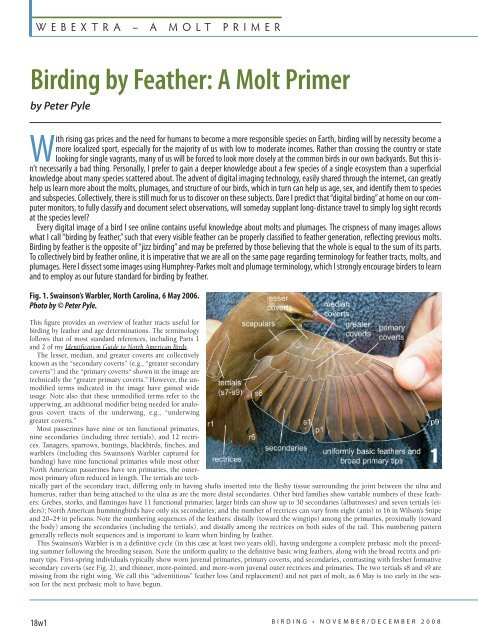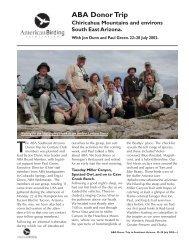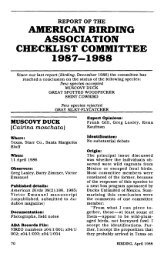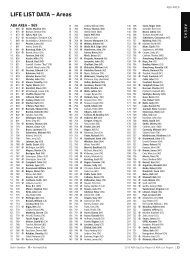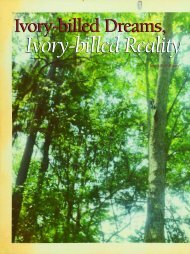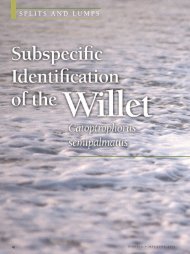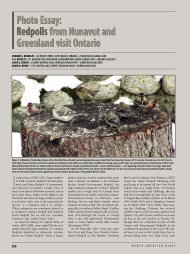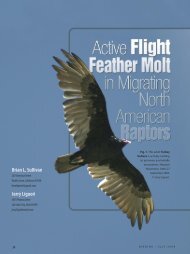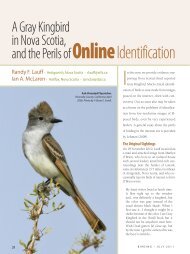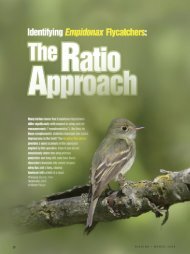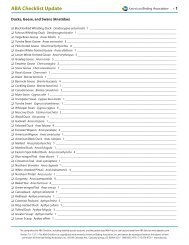Birding by Feather: A Molt Primer - American Birding Association
Birding by Feather: A Molt Primer - American Birding Association
Birding by Feather: A Molt Primer - American Birding Association
- No tags were found...
You also want an ePaper? Increase the reach of your titles
YUMPU automatically turns print PDFs into web optimized ePapers that Google loves.
W E B E X T R A –A M O L T P R I M E R<strong>Birding</strong> <strong>by</strong> <strong>Feather</strong>: A <strong>Molt</strong> <strong>Primer</strong><strong>by</strong> Peter PyleWith rising gas prices and the need for humans to become a more responsible species on Earth, birding will <strong>by</strong> necessity become amore localized sport, especially for the majority of us with low to moderate incomes. Rather than crossing the country or statelooking for single vagrants, many of us will be forced to look more closely at the common birds in our own backyards. But this isn’tnecessarily a bad thing. Personally, I prefer to gain a deeper knowledge about a few species of a single ecosystem than a superficialknowledge about many species scattered about. The advent of digital imaging technology, easily shared through the internet, can greatlyhelp us learn more about the molts, plumages, and structure of our birds, which in turn can help us age, sex, and identify them to speciesand subspecies. Collectively, there is still much for us to discover on these subjects. Dare I predict that “digital birding” at home on our computermonitors, to fully classify and document select observations, will someday supplant long-distance travel to simply log sight recordsat the species level?Every digital image of a bird I see online contains useful knowledge about molts and plumages. The crispness of many images allowswhat I call “birding <strong>by</strong> feather,” such that every visible feather can be properly classified to feather generation, reflecting previous molts.<strong>Birding</strong> <strong>by</strong> feather is the opposite of “jizz birding” and may be preferred <strong>by</strong> those believing that the whole is equal to the sum of its parts.To collectively bird <strong>by</strong> feather online, it is imperative that we are all on the same page regarding terminology for feather tracts, molts, andplumages. Here I dissect some images using Humphrey-Parkes molt and plumage terminology, which I strongly encourage birders to learnand to employ as our future standard for birding <strong>by</strong> feather.Fig. 1. Swainson’s Warbler, North Carolina, 6 May 2006.Photo <strong>by</strong> © Peter Pyle.This figure provides an overview of feather tracts useful forbirding <strong>by</strong> feather and age determinations. The terminologyfollows that of most standard references, including Parts 1and 2 of my Identification Guide to North <strong>American</strong> Birds.The lesser, median, and greater coverts are collectivelyknown as the “secondary coverts” (e.g., “greater secondarycoverts”) and the “primary coverts“ shown in the image aretechnically the “greater primary coverts.” However, the unmodifiedterms indicated in the image have gained wideusage. Note also that these unmodified terms refer to theupperwing, an additional modifier being needed for analogouscovert tracts of the underwing, e.g., “underwinggreater coverts.”Most passerines have nine or ten functional primaries,nine secondaries (including three tertials), and 12 rectrices.Tanagers, sparrows, buntings, blackbirds, finches, andwarblers (including this Swainson’s Warbler captured forbanding) have nine functional primaries while most other1North <strong>American</strong> passerines have ten primaries, the outermostprimary often reduced in length. The tertials are technicallypart of the secondary tract, differing only in having shafts inserted into the fleshy tissue surrounding the joint between the ulna andhumerus, rather than being attached to the ulna as are the more distal secondaries. Other bird families show variable numbers of these feathers:Grebes, storks, and flamingos have 11 functional primaries; larger birds can show up to 30 secondaries (albatrosses) and seven tertials (eiders);North <strong>American</strong> hummingbirds have only six secondaries; and the number of rectrices can vary from eight (anis) to 16 in Wilson’s Snipeand 20–24 in pelicans. Note the numbering sequences of the feathers: distally (toward the wingtips) among the primaries, proximally (towardthe body) among the secondaries (including the tertials), and distally among the rectrices on both sides of the tail. This numbering patterngenerally reflects molt sequences and is important to learn when birding <strong>by</strong> feather.This Swainson’s Warbler is in a definitive cycle (in this case at least two years old), having undergone a complete prebasic molt the precedingsummer following the breeding season. Note the uniform quality to the definitive basic wing feathers, along with the broad rectrix and primarytips. First-spring individuals typically show worn juvenal primaries, primary coverts, and secondaries, contrasting with fresher formativesecondary coverts (see Fig. 2), and thinner, more-pointed, and more-worn juvenal outer rectrices and primaries. The two tertials s8 and s9 aremissing from the right wing. We call this “adventitious” feather loss (and replacement) and not part of molt, as 6 May is too early in the seasonfor the next prebasic molt to have begun.18w1B I R D I N G • N O V E M B E R / D E C E M B E R 2 0 0 8
Fig. 2a. Ovenbird, North Carolina, 9 May 2006.Photo <strong>by</strong> © Peter Pyle.JFig. 2b. Pine Warbler, California, 26 February 2008.Photo <strong>by</strong> © Robert Harrington.FFig. 2c. Grace’s Warbler, California, 21 October 2007.Photo <strong>by</strong> © Douglas Aguillard.2areplaced formativegreater covertsJworn, brown, and pointedjuvenal primary tipsretained juvenalprimary covertsFig. 2a shows the wing of a first-cycle (~1-year-old) Ovenbirdthat was captured for banding. In contrast to the Swainson’sWarbler (Fig. 1), note the “molt limits” between the retained,worn, juvenal (J) secondaries, primaries, and (especially) primarycoverts, and the fresher and better-quality, replaced,formative (F), lesser, median, and greater coverts. This replacementpattern, known among banders as the “block pattern,”is typical of most first-cycle warblers, vireos, andsparrows following the preformative molt. The primarycoverts are often visible on sitting birds, and can be used toage many warblers, sparrows, vireos, and other passerines inthe field.For example, the Pine Warbler in Fig. 2b can also be agedas a first-cycle bird due to the brown, retained juvenal primarycoverts, contrasting with the darker, replaced formativegreater coverts, and the worn and brown juvenal primary tips.In contrast, the Grace’s Warbler in Fig. 2c has blackish basicprimary coverts with grayish edging, uniform in color andquality with the greater coverts, and broad and blackish basicprimary tips and rectrices. Our ability to determine that thisfemale Grace’s Warbler was in its definitive cycle (and >1 yearold) helped confirm it as a returning vagrant from the winterbefore. The McGill Bird Observatory Photo Library and thePowdermill Avian Research Center Bird-Banding websites offerhundreds of images and extensive further tips on agingpasserines in the hand <strong>by</strong> molt limits.2b2cuniformly basicwing feathersbroad andblackish basicprimary tips andrectricesblackish basicprimary covertsW W W . A B A . O R G18w2
W E B E X T R A –A M O L T P R I M E RFig. 3a. Indigo Bunting, Indiana, May 2007.Photo <strong>by</strong> © Peter Pyle.Fig. 3b. Lazuli Bunting, Arizona, July 2007.Photo <strong>by</strong> © Peter Pyle.The images show a first-cycle Indigo Bunting and definitivecycleLazuli Bunting captured for banding. Passerina buntingshave what is known as “eccentric” preformative molts, duringwhich outer primaries (but not primary coverts) and innersecondaries are replaced, leaving a block of juvenal outer secondariesand inner primaries in the center of the wing. Eccentricpreformative molts occur in some sandpipers, flycatchers,shrikes, wrens, thrashers, sparrows, orioles, and other taxa,many of which inhabit xeric habitats and/or sunny, opencountry.On the Indigo Bunting (Fig. 3a), note the contrast in freshness,quality, and shaft color between the retained juvenal (J)inner primaries (p1–p4), and the replaced formative (F) outerprimaries (p5–p9), and between the retained juvenal primarycoverts and outer secondaries (s5–s1), and the replaced formativeouter greater coverts. The lesser and median coverts, theinner four greater coverts, s6, and most of the body featherswere replaced during the first prealternate molt (marked A1),whereas the tertials and some body feathers were replaced duringthe preformative molt but retained during the first prealternatemolt. All of these contrasts indicate a first-cycle individualin spring, approaching one year of age.The adult Lazuli Bunting (Fig. 3b), in comparison, has uniformlydefinitive basic feathers. Note especially the color ofthe definitive primary coverts compared to the juvenal covertsof the Indigo Bunting. Note also the subtle difference betweenthe fresher s1 and the more worn p1, caused <strong>by</strong> a gap of 2–3weeks between the replacement of these two feathers (s1 istypically replaced when primary replacement has reached p5or p6), resulting in what banders call an “s1–p1 contrast.”This contrast is especially useful in aging adults of specieswith protracted and complete prebasic molts. Good online examplesinclude a definitive-cycle Pink-footed Shearwater anda definitive-cycle Buller’s Shearwater, both photographed <strong>by</strong>Bill Schmoker.Interestingly, Lazuli Buntings lack the extensive prealternatemolts found in both first-year and adult Indigo Buntings.Specifically, the prealternate molt in this Lazuli Bunting involved most lesser coverts but no other feathers of the wing. The definitive prealternatemolt of Indigo Bunting, in contrast, typically includes most or all wing coverts and tertials. The question is still wide-open: What accountsfor the extensive variation in the prealternate molts among species of Passerina?A1FFbasic primary coverts,black with blue fringinguniformly basic greatercoverts and remigesJJFalternate lessercoverts3a3b18w3B I R D I N G • N O V E M B E R / D E C E M B E R 2 0 0 8
Fig. 4a. Lazuli Bunting, Connecticut, January 2007.Photo <strong>by</strong> © Julian Hough.4amolt limits betweenretained juvenal innerprimaries (p1-p5) andouter secondary (s1),and replaced formativeouter primaries(p6-p10) and innersecondaries (s2-s10),after an eccentricpreformative moltbrown primarycoverts (just visible)brown-edged, retainedjuvenal inner primariesand outer secondariesfresher formativetertialsblue-edged,replaced formativeouter primariesFig. 4b. Red-necked Stint, Indiana, 23 May 2006.Photo <strong>by</strong> © Leland Shaum.Crisp digital images can allow the detection of eccentricmolts in the field. This vagrant first-cycle Lazuli Bunting(Fig. 4a) shows contrast between the newer, formative,bluer-edged outer primaries (p5–p9) and the retained, juvenal,browner-edged inner primaries (p1–p4) and outersecondaries, and between the fresher formative tertials andthe older juvenal secondaries. Birds with eccentric moltpatterns typically replace all rectrices: The blacker formativerectrices, edged blue basally, indicate a male, whereasfemales have browner formative rectrices with duller andmore-greenish edging.Likewise, this vagrant Red-necked Stint (Fig. 4b) showsan eccentric pattern and is therefore in its first cycle. Notethe juvenal outermost secondary (s1) and inner primaries(p1–p5) contrasting with the darker formative inner secondariesand outer primaries. These were the only juvenalfeathers retained during the preformative molt of this individualand the only indication as to its age.4brectrices and remainderof feathers formative orfirst alternateW W W . A B A . O R G18w4
W E B E X T R A –A M O L T P R I M E RFig. 5. Red Knot, California, 2 May 2007.Photo <strong>by</strong> © Jim Scarff.fresherformativecoverts?wornjuvenalcoverts?alternatescapularsand a fewcovertsThis Red Knot shows worn and frayed median and greatercoverts, along with pointed primary tips typical of manyfirst-cycle shorebirds in spring. However, it also shows arather extensive breeding-plumage aspect for a first-cycleindividual of this species. It appears that there may be somefresher formative lesser coverts resulting in molt limitswithin this tract and indicating a first-spring individual,but age in such cases should be confirmed <strong>by</strong> examinationof the open wing.First-spring shorebirds can vary in appearance from acomplete non-breeding aspect to obtaining a “full” or nearfull,definitive breeding aspect (as with the Red-neckedStint, Fig. 4b). Birds displaying a complete non-breedingaspect are often still in “alternate plumage” (indicating thatat least some feathers were replaced during the prealternatemolt), but the alternate feathers may be few, and/or maynot have acquired a breeding aspect due to hormonal cyclesand other factors. <strong>Molt</strong>s and plumages of shorebirds alsoshow extensive variation based on wintering latitude; individualsgoing to the southern hemisphere generally having more-extensive preformative molts and more-protracted prebasic and prealternatemolts than those remaining in the northern hemisphere. Red Knots and several other shorebird species can be especially variablein plumage aspect due to the wide latitudinal wintering range, spanning both hemispheres. For this reason, I believe that the RedKnot is actually monotypic (meaning that no subspecies exist). Instead, I hypothesize that observed plumage variation relates more toenvironmental factors (e.g., those associated with winter latitude) than genetic factors differentiating populations.5Fig. 6. White-tailed Eagle, Hawaii, 5 March 2005.Photo <strong>by</strong> © Brenda Zaun.Many large birds that need to maintain flight while moltingundergo a pattern of remex replacement known as “staffelmauser”or “stepwise molt.” A series of incomplete prebasicmolts eventually results in multiple waves of replacementthrough the feather tracts. Among the primaries,staffelmauser results in “sets” of contiguous feathers replacedduring a molt, with starting points defined <strong>by</strong> afresher inner feather adjacent to a more-worn outer feather.As long as the outer primary is not juvenal, the numberof sets defines the minimum age of the bird in terms ofmolt cycles, which for temperate species usually equates toyears. This White-tailed Eagle has five sets of definitive primariesin each wing (divisions marked <strong>by</strong> the arrows) andis thus in at least its fifth molt cycle and year of life. Sets onthe right wing include p1, p2–p4, p5–p7, p8–p9, and p10,and those on the left wing include p1–p2, p3–p4, p5–p6,p7–p8, and p9–p10.It is not uncommon for the wings to lose symmetry in replacementpatterns after several years of molt. If the outerarrows indicate boundariesbetween sets of primaries instaffelmauser pattern; notethat outer feather is moreworn than the inner feather ineach case, indicatingtermination of molt wavesprimary in such cases is juvenal (usually recognized <strong>by</strong> being pointed and significantly bleached), the number of sets defines the cycle;thus, a bird with sets at p1–p4, p5–p9, and p10, with p10 juvenal, is in its third cycle and would be approaching three years old inspring. Secondaries in most large birds are replaced inward from s1 and s5 and outward from the tertials. Sets of feathers also occurwithin this tract but, due to the complex replacement sequence, patterns become obscured once all juvenal feathers have been replaced.Look for staffelmauser patterns in images of North <strong>American</strong> eagles, ospreys, Buteo hawks, boobies, pelicans, frigatebirds, cormorants,herons, and a few other taxa. With practice and a good image of the upper surface of the wing, staffelmauser can easily be recognizedon live birds in the field.618w5B I R D I N G • N O V E M B E R / D E C E M B E R 2 0 0 8
7arrows indicate olderfeathers, not replacedduring the most recentprebasic moltFig. 7. Sandhill Crane, New Mexico,21 November 2005.Photo <strong>by</strong> © Bill Schmoker.North <strong>American</strong> cranes exhibit odd andunique patterns of remigial molt that arefar from fully understood. In SandhillCrane, individuals from resident southernpopulations appear to undergo staffelmauserpatterns as described previously(Fig. 6), whereas individuals from migratorypopulations can replace all secondariesand primaries synchronously, be comingflightless during molt. These completesimultaneous wing molts in SandhillCranes may occur only once every otheryear, and in Whooping Cranes once everythird year (Marty Folk, personal communication).But some Sandhill Cranes canmolt primaries and secondaries in differentpatterns from those described above,seemingly almost random at times, andnot well-understood. Some appear to molt feathers in synchronous blocks of 5–6 contiguous feathers, with differentsets replaced in alternate years.The Sandhill Crane depicted here had replaced p1–p4 and p6 during the preceding prebasic molt, leaving p5 andp7–p10 as retained feathers from a previous generation (arrows in image). The secondaries also show at least two generations,with s1–s5, s9, and s11 newer and the other visible feathers older (arrows). Note also that the outer greatercoverts and inner primary coverts had been retained in patterns not coinciding with corresponding secondaries andprimaries, respectively. The older primaries and secondaries appear not to be juvenal feathers (which would be narrowerand more bleached), indicating at least two wing molts have occurred since the first cycle and a bird of at leastthree years of age (note also the full red head patch, typically gained during the third cycle). Whether or not the replacementsequence of this individual fits into some sort of broader pattern awaits further analyses, perhaps with digitalimages and <strong>by</strong> birding <strong>by</strong> feather.W W W . A B A . O R G18w6


